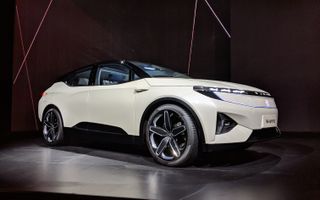Latest Byton Concept Car Has Five Screens — and You'll Drive It Next Year
Startup Byton turned heads at CES last year for its pillar-to-pillar dashboard touch screen in its prototype electric SUV. Now, it's adding even more screens to the mix.
LAS VEGAS — Last year's Consumer Electronics Show served as most of the world's introduction to Byton, a startup automaker based out of China working on an all-electric crossover named the M-Byte. The M-Byte is still on target for a late-2019 release in China, Byton tells us, with an eye toward a U.S. rollout in 2020. But until then, the company has unveiled new details about the M-Byte, along with its futuristic user interface.

Byton's most notable contribution to the in-car experience is inarguably its 48-inch touch screen that dominates — no, completely replaces — the dashboard you would expect on a conventional car. This display will be featured in both the M-Byte and an autonomous sedan the company is also working on, called the K-Byte.
Yet Byton's evidently decided one really long screen isn't enough, because it's introduced two more — one baked into the center of the steering wheel, and another down near the center console. This trio of screens garnered most of the attention at Byton's press conference today (Jan. 6) at CES.
The display the driver interacts with measures 7 inches diagonally, and both acts as a standalone panel or as a touchpad for the primary 48-inch screen. The same goes for the passenger’s screen, which is 8 inches large and has one notable additional feature, in that it can view and respond to text messages with its own built-in digital keyboard.

Underpinning these three displays — and another two in the back for rear-seat passengers — is one operating system, called Byte OS. Byte OS is a multifaceted platform, in that it’s designed to to accommodate everything from passenger comfort, to infotainment, video chatting and even AI-assisted suggestions for restaurants. Byton has announced Byte OS will support Amazon Alexa integration as well.
While touch screens are fancy and futuristic, they do come with one critical flaw for drivers. It becomes awfully hard to keep your eyes on the road when you have to cooperate with an interface system that provides no physical feedback.

To get around that, Byton’s conceded the all-digital motif somewhat with surprisingly traditional control points, like a set of good old-fashioned buttons flanking the steering wheel display. There are even two stalks on both sides of the wheel itself, exactly where you’d expect them to be, for your turn signals, windshield wipers, lights and so on. (The model pictured here that Byton brought to CES doesn't have the latest interior fitted, but the company tells us these details are true of the car's final form.)
Sign up to get the BEST of Tom’s Guide direct to your inbox.
Upgrade your life with a daily dose of the biggest tech news, lifestyle hacks and our curated analysis. Be the first to know about cutting-edge gadgets and the hottest deals.
Byton says the most recent M-Byte prototype is 80-to-90 percent similar to what the final version will be when it begins rolling off the production line at the company’s Nanjing, China plant near the end of the year. After that, the K-Byte will follow in 2021, as well as an eventual third model — a seven-seater SUV — in 2023. Many are skeptical of Byton's ability to hit the market so soon, but one thing is certain: it's showing no intention to slow down.
Adam Ismail is a staff writer at Jalopnik and previously worked on Tom's Guide covering smartphones, car tech and gaming. His love for all things mobile began with the original Motorola Droid; since then he’s owned a variety of Android and iOS-powered handsets, refusing to stay loyal to one platform. His work has also appeared on Digital Trends and GTPlanet. When he’s not fiddling with the latest devices, he’s at an indie pop show, recording a podcast or playing Sega Dreamcast.
